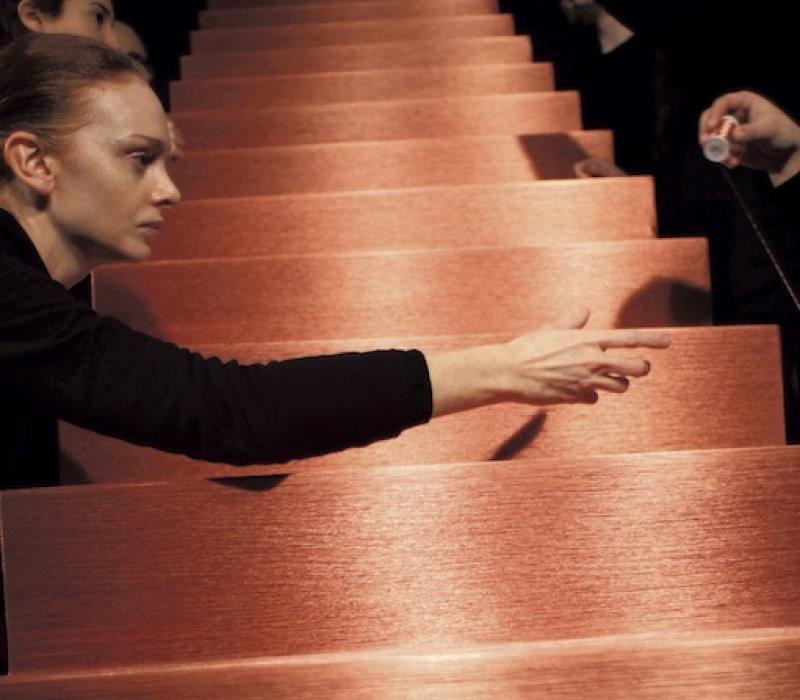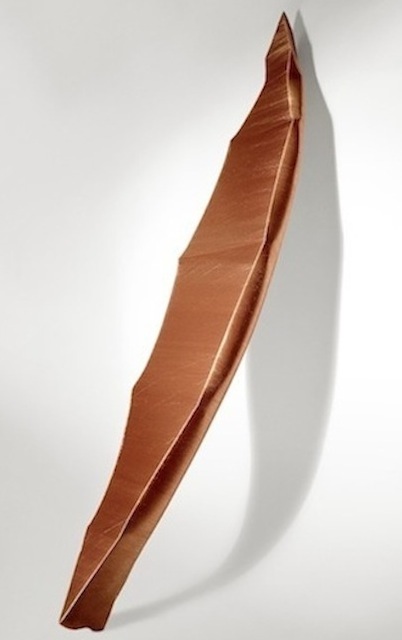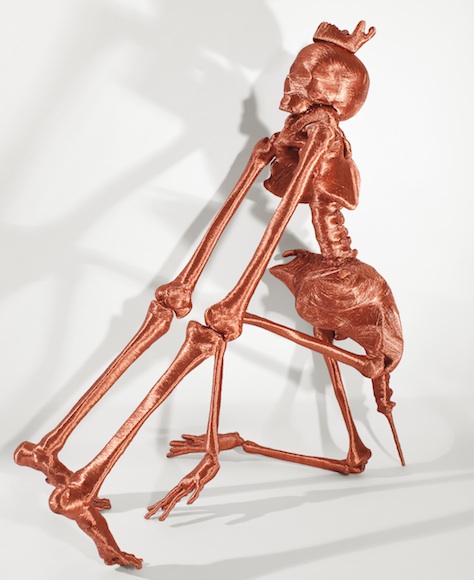Alice Anderson, Wellcome Collection | reviews, news & interviews
Alice Anderson, Wellcome Collection
Alice Anderson, Wellcome Collection
The artist who wraps the world in gleaming copper wire – but to what end?

A flight of golden stairs gleams seductively under the spot lights; free of architectural constraints, it serves no practical purpose other than to encourage the mind to wander and perhaps to imagine it as the stairway to heaven. The beauty, simplicity and purity of the structure promise a trouble free ascent to astral spheres; one can almost hear the strings of angelic harps twanging celestial harmonies up above.
Wound round the treads, miles of fine copper wire clarify rather than conceal the form; while evidently remaining a staircase, Alice Anderson’s Stairs, 2014, transcends its quotidian origins to become a sculpture, a physical object that gains its meaning from the realm of metaphor – through the viewer’s mental rather than physical engagement with it.
Jars, 2012, a stack of conical vases bound in copper wire, is similarly beguiling. Referring to modernist sculpture rather than to architecture, the work echoes Brancusi’s famous Endless Column, 1938, a towering stack of identical units considered the finest outdoor sculpture the of 20th century. If Brancusi’s column commemorates the Romanian soldiers who died in World War One, Anderson’s work is also about memory and the rituals we use to bind things to us.
 Canoe, 2013 (pictured left), is the most compelling example. Cocooned in copper wire, the mummified canoe reminds one of the vessels in which the dead were sometimes buried in the past and of the belief common to many cultures that the deceased are ferried to a final resting place across infernal waters, such as the river Styx. The focused concentration required to encase the boat in wire reminds one of a funerary ritual, especially as wrapping the object removes it from the realm of the everyday and propels it into the domain of memory.
Canoe, 2013 (pictured left), is the most compelling example. Cocooned in copper wire, the mummified canoe reminds one of the vessels in which the dead were sometimes buried in the past and of the belief common to many cultures that the deceased are ferried to a final resting place across infernal waters, such as the river Styx. The focused concentration required to encase the boat in wire reminds one of a funerary ritual, especially as wrapping the object removes it from the realm of the everyday and propels it into the domain of memory.
For years now, Anderson has been obsessively wrapping things, at first in auburn hair and, more recently, in copper wire. Using wire is an interesting alternative to casting mundane objects, including staircases, in plaster (as Rachel Whiteread has done since the late 1980s) or in bronze (as numerous artists including Gavin Turk and Tracey Emin have done since the 1990s). But wrapping is significantly different from casting. Rather than elevating an insignificant object, like a pipe or bin liner (Turk) or a child’s sock and mitten (Emin), into an artwork through a process which destroys the original, wrapping preserves the item while removing it from ordinary usage.
How to chose what to wrap up, though? The ancient Egyptians and Chinese were laid to rest with things that would ease their entry into the afterlife and provide comfort in the hereafter. This could mean anything from horses, carriages and slaves to jewellery, clothing, money, food and precious herbs or spices.
A coke bottle is among the items chosen by Anderson. Its distinctive shape makes it immediately recognisable and, wrapped in copper wire, it gleams with promise – a reminder of the power of global marketing that has become lodged in our collective memory bank as an icon of consumerism. The galleries are filled with things and, while the laptop, video camera and plasma screen have clearly been chosen to represent our moment in history, others – from a tagine pot, to glasses, paint tubes, a pair of binoculars, batteries, a radio, telephone, slide projector, bicycle, stethoscope, pipe, toaster and globe – could have been selected at random.
And once the mummified shapes have been identified, they don’t necessarily resonate beyond the moment of recognition. This is especially true of assemblages in which bones and Apple Mac plugs (pictured below) or a hoover, fax machine, telephone and vinyl discs have been united by copper wire into weird hybrids. As soon as the ingredients have been identified, one’s interest dwindles.
 The Bull’s Head, famously made by Picasso in 1942 from a bicycle saddle and handle bars, remains a delight because the dual identity foisted on the objects – as bicycle parts and a head with horns – is so witty. Muffled in wire, Anderson’s elements fail to elicit a conversation between their old and new identities and so remain confused.
The Bull’s Head, famously made by Picasso in 1942 from a bicycle saddle and handle bars, remains a delight because the dual identity foisted on the objects – as bicycle parts and a head with horns – is so witty. Muffled in wire, Anderson’s elements fail to elicit a conversation between their old and new identities and so remain confused.
Some ruthless editing would improve the exhibition no end. But it is being promoted as a touchy-feely collaboration with the public. Viewers are invited to wrap up anything from a pair of high heels to a typewriter, laptop, clock, electric plug or 1967 Ford Mustang. The car may have some significance for the artist, but I can’t help feeling that a Jaguar, Mini or Rolls Royce would have been a more appropriate choice than a clapped out American banger.
The question that ultimately arises is whose memory is being served? Is Anderson celebrating collective experience – as in the staircase, canoe and coke bottle – or is she focusing on personal memories? Is she hoping to create icons that resonate with our time or quirky individual pieces whose meaning remains muffled and somewhat obscure? I’m not sure that she has decided yet.
Explore topics
Share this article
more Visual arts
 Eye to Eye: Homage to Ernst Scheidegger, MASI Lugano review - era-defining artist portraits
One of Switzerland's greatest photographers celebrated with a major retrospective
Eye to Eye: Homage to Ernst Scheidegger, MASI Lugano review - era-defining artist portraits
One of Switzerland's greatest photographers celebrated with a major retrospective
 Stephen review - a breathtakingly good first feature by a multi-media artist
Melanie Manchot's debut is strikingly intelligent and compelling
Stephen review - a breathtakingly good first feature by a multi-media artist
Melanie Manchot's debut is strikingly intelligent and compelling
 Fantastic Machine review - photography's story from one camera to 45 billion
Love it or hate it, the photographic image has ensnared us all
Fantastic Machine review - photography's story from one camera to 45 billion
Love it or hate it, the photographic image has ensnared us all
 Yinka Shonibare: Suspended States, Serpentine Gallery review - pure delight
Weighty subject matter treated with the lightest of touch
Yinka Shonibare: Suspended States, Serpentine Gallery review - pure delight
Weighty subject matter treated with the lightest of touch
 Jane Harris: Ellipse, Frac Nouvelle-Aquitaine MÉCA, Bordeaux review - ovals to the fore
Persistence and conviction in the works of the late English painter
Jane Harris: Ellipse, Frac Nouvelle-Aquitaine MÉCA, Bordeaux review - ovals to the fore
Persistence and conviction in the works of the late English painter
 Sargent and Fashion, Tate Britain review - portraiture as a performance
London’s elite posing dressed up to the nines
Sargent and Fashion, Tate Britain review - portraiture as a performance
London’s elite posing dressed up to the nines
 Zineb Sedira: Dreams Have No Titles, Whitechapel Gallery review - a disorientating mix of fact and fiction
An exhibition that begs the question 'What and where is home?'
Zineb Sedira: Dreams Have No Titles, Whitechapel Gallery review - a disorientating mix of fact and fiction
An exhibition that begs the question 'What and where is home?'
 Yoko Ono: Music of the Mind, Tate Modern review - a fitting celebration of the early years
Acknowledgement as a major avant garde artist comes at 90
Yoko Ono: Music of the Mind, Tate Modern review - a fitting celebration of the early years
Acknowledgement as a major avant garde artist comes at 90
 Unravel: The Power and Politics of Textiles in Art, Barbican review - the fabric of dissent
An ambitious exploration of a neglected medium
Unravel: The Power and Politics of Textiles in Art, Barbican review - the fabric of dissent
An ambitious exploration of a neglected medium
 When Forms Come Alive, Hayward Gallery review - how to reduce good art to family fun
Seriously good sculptures presented as little more than playthings or jokes
When Forms Come Alive, Hayward Gallery review - how to reduce good art to family fun
Seriously good sculptures presented as little more than playthings or jokes
 Entangled Pasts 1768-now, Royal Academy review - an institution exploring its racist past
After a long, slow journey from invisibility to agency, black people finally get a look in
Entangled Pasts 1768-now, Royal Academy review - an institution exploring its racist past
After a long, slow journey from invisibility to agency, black people finally get a look in
 Barbara Kruger, Serpentine Gallery review - clever, funny and chilling installations
Exploring the lies, deceptions and hyperbole used to cajole, bully and manipulate us
Barbara Kruger, Serpentine Gallery review - clever, funny and chilling installations
Exploring the lies, deceptions and hyperbole used to cajole, bully and manipulate us

Add comment